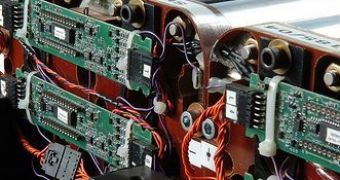Researchers at Fudan University in Shanghai, China, are working on improving the performances of water-based lithium-ion batteries. This might just be the new safer and cheaper way of storing power from solar panels or wind turbines.
Common lithium-ion batteries are made from two electrodes within a liquid electrolyte, such as ethylene carbonate. This electrolyte allows lithium ions to move from an electrode to the other, as the battery charges and discharges. This type of batteries is used everywhere, from your personal laptop to your mobile phone. The problem is that that lithium-ion batteries can be a safety hazard sometimes, because of the flammable and toxic organic solvents inside. Their fabrication is also quite expensive and if they ever overcharge or short-circuit they can rupture or ignite.
The idea is that the water-based lithium-ion batteries would be less expensive and much safer for large-scale use, like power generation or car batteries. And this is actually possible, by using specially-designed electrodes, except that the technology is not yet reliable, as even the best aqueous cells lose half of their storage capacity after 100 recharges, according to RSC.
Chinese scientists have figured out the cause of this instability and as they removed oxygen from the power cells, the performances improved significantly. They used carbon-coated electrodes of lithium iron phosphate (LiFePO4) and lithium titanium phosphate (LiTi2(PO4)3) and eliminated as much oxygen from the cells as possible. Research leader Yong-Yao Xia explains: “The materials used to make negative electrodes react with water and oxygen when discharged. By completely eliminating oxygen from the system and using carbon-coated electrodes, we were able to greatly improve the stability.”
Removing the oxygen allowed batteries to keep 90 percent of their storage capacity after being charged and discharged over 1000 times. “This is a big step forward, but there is still a long way to go before these batteries find practical applications,” Xia said to Chemistry World. We now plan to hunt for electrode materials that cannot dissolve in the water - or find a surface modification that reduces this process even more.”
Yi Cui, an expert in battery design at Stanford University in California, US says that “due to the energy density of water, aqueous lithium-ion batteries store less power than organic-based batteries, but reducing the price and solving the safety issues are very important. The batteries probably won't replace the ones that are currently used in mobile phones - but they have big advantages for larger scale energy storage.”

 14 DAY TRIAL //
14 DAY TRIAL //